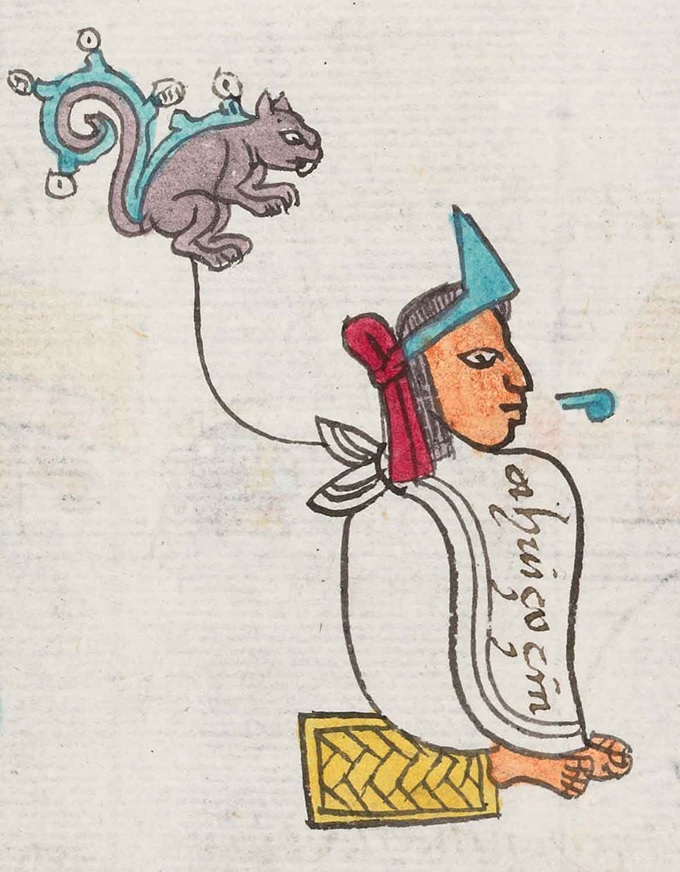Auítzotl

Auítzotl (also Ahuitzotl , Aztec for 'water dog' Nahuatl aːˈwit͡sot͡ɬ "Awisotl" ; † 1502 ) was ruler of the Aztecs from 1486 to 1502. He was the brother of his predecessors Tízoc and Axayacatl .
Live and act
The Aztecs had emerged from the reign of Tízoc weakened in foreign policy. This is shown by the fact that the heads of the neighboring states sharply rejected the usual invitation to the accession ceremonies. Another sign of this is that the Aztec sources named places as war targets of the Auítzotl that had already been conquered by previous rulers, such as the Valley of Toluca . These are places that fell away from the Aztecs during the reign of Tízoc.
Large numbers of warriors were captured during these campaigns and sacrificed during the rededication of the Templo Mayor . Auítzotl used the celebration as a demonstration of the strengthened power of the Aztecs and invited the rulers of the neighboring cities, who actually accepted the invitation this time.
After all the abandoned or fickle areas had been incorporated again, Auítzotl proceeded against some fortified cities that the Tarasken had built along the Río Balsas . The Aztec warriors almost completely destroyed them; the population was almost completely killed. Following this, families from Tlacopán and Texcoco were resettled to defend the new border. Then, around the turn of the century, the Aztecs embarked on the longest campaign in their history, the conquest of Xoconochco on what is now the Mexican-Guatemalan border. After their subjugation, the new province delivered rich tribute payments in the form of bird feathers and cocoa to Tenochtitlán . This was followed by the subjugation of the city of Huexotla (today's Huejutla in the state of Hidalgo ) on the Gulf coast, while at the same time King Nezahualpilli of Texcoco extended the previously controlled areas on the Gulf coast further south. A campaign against the Tlaxcalc and their allied cities of Cholula and Huexotzinco ended near the settlement of Atlixco in a heavy defeat for the Aztecs. In this battle, along with several other members of the nobility, Auítzotl's nephew Tlacahuepan , a son of Axayacatl, was killed .
In Tenochtitlán an attempt was made in 1498 to make a water source in the southwest of the city usable through an aqueduct . The water pipe, however, was oversized and flooded Tenochtitlán for several days, a large part of which was destroyed. To stop the rush of water, Auítzotl tried to appease the gods by sacrificing some explorers of the source and had part of the aqueduct destroyed.
While the flood was still ongoing, Auítzotl suffered a serious head injury from a falling roof beam in his palace and, according to tradition, lost his mind. Even so, he formally remained the ruler of the Aztecs until his death in 1502. Since some of the discoverers of the source were members of the Council of State, the son or brother of the previous ruler was not declared his representative and later a tlatoani , as is usually the case , but his nephew Moctezuma II , who had already proven his skills as a general .

literature
- Hanns J. Prem : History of ancient America . Oldenbourg, Munich 1989 (2nd revised edition 2007). ISBN 3-486-53032-1 .
- Hanns J. Prem: The Aztecs. Culture - history - religion . Verlag CH Beck, Munich 2006. ISBN 3-406-45835-1 .
- Ross Hassig: Aztec Warfare. Imperial Expansion and Political Control. University of Oklahoma Press, Norman 1988. ISBN 0-8061-2121-1 .
Web links
| personal data | |
|---|---|
| SURNAME | Auítzotl |
| ALTERNATIVE NAMES | Ahuitzotl |
| BRIEF DESCRIPTION | Aztec rulers |
| DATE OF BIRTH | 15th century |
| DATE OF DEATH | 1502 |